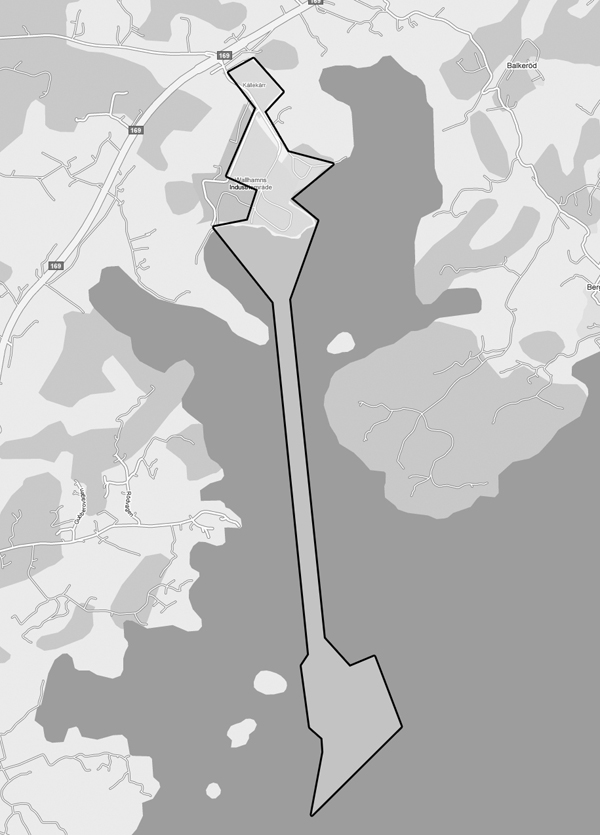Local Regulations and Safety Rules for Wallhamn in the Municipality of Tjörn
Decided by the County Administrative Board of Västra Götaland County on May 12, 2009.
The County Administrative Board stipulates the following under the authority of Section 4 of the Regulation (1993:1632) authorizing County Administrative Boards to issue local regulations under the Public Order Act (1993:1617).
Preliminary Provisions
§ 1. Basic provisions regarding public order and safety in public places are outlined in Chapter 3 of the Public Order Act. These local regulations contain additional provisions concerning order and safety in Wallhamn considering the activities conducted in the harbor.
For the part of the harbor area that is considered a public place, the municipality's general local order regulations also apply.
§ 2. These regulations apply both in water and on land within the harbor area marked on the map attached to these regulations. The harbor area is managed by Wallhamn AB.
§ 3. The term "harbor authority" in these regulations refers to the Chief Executive Officer or the Harbor Master.
§ 4. The term "vessel" in these regulations refers to any object used for transportation on water and any other object that can be moved on or in water.
Traffic Regulations
§ 5. Vessels must be operated in a manner that avoids creating danger or obstacles for other maritime traffic. Furthermore, vessels must be operated in a way that does not endanger or cause harm to other vessels, facilities, or individuals. The vessel's master must exercise particular caution when passing areas where work is being conducted in the water.
§ 6. Aircraft are not allowed to land within the harbor area without permission from the harbor authority.
§ 7. Recreational boats must not approach merchant vessels closer than 50 meters.

Map of the Harbor Area
Mooring, Anchoring, Movement, etc.
§ 8. Vessels may only be placed, moored, or anchored in locations designated by the harbor authority.
The vessel's master must be informed about the water depth at the designated berthing, mooring, or anchoring location.
§ 9. Storing vessels can only take place with permission from the harbor authority. The vessel's master, shipowner, or owner must ensure that the vessel is securely moored.
§ 10. When mooring, anchoring, or moving, the vessel's master must ensure that other vessels, quays, piers, or similar facilities, as well as cables or lines, are not damaged, and that vessel traffic is not unnecessarily obstructed or disturbed.
§ 11. Establishing mooring places or laying down pipelines, cables, or other lines, pontoons, temporary bridge connections, and similar installations is not allowed without permission from the harbor authority.
§ 12. The vessel's master, shipowner, or owner must move or reposition the vessel or take other necessary actions concerning the vessel to maintain order or safety within the harbor.
§ 13. Vessels that pose a risk of sinking, obstructing vessel traffic, or otherwise endangering order or safety within the harbor area are not allowed to enter the harbor area.
§ 14. The vessel's master, shipowner, owner, or agent for any of these parties must immediately report to the harbor authority if a vessel has sunk, run aground, or become inoperable in any other way.
If an item other than a vessel has sunk and could obstruct or damage vessels or facilities, the owner must report this to the harbor authority. If someone other than the owner was in possession of the item when it sank, that person is responsible for reporting it. If the item was lost from a vessel, the vessel's master, shipowner, or owner must report it.
§ 15. When mooring, anchoring, or moving, assistance from a tugboat must be utilized if necessary for the sake of order or safety within the harbor area.
Reporting Obligations
§ 16. If a vessel is to enter or pass through the harbor, the vessel's master, shipowner, or agent for any of these parties must report this to the harbor authority.
The report must be made as early as possible, but no later than 24 hours before the vessel's arrival. The harbor authority may allow a shorter notification time or exemption from the reporting obligation based on the duration of the vessel's journey or other circumstances.
The vessel's master must report the departure time to the harbor authority when the vessel is ready to depart.
Loading, Unloading, Storing Cargo, etc.
§ 17. Cargo, vehicles, or other equipment must be handled, placed, or stored in locations designated by the harbor authority in a manner that does not damage harbor plans, buildings, pavement, tracks, cranes, or other elements or block emergency pathways or pose a danger to people.
Specific regulations exist for reporting and handling hazardous materials.
Special Order Regulations
§ 18. Before major repair or maintenance work, or equivalent work from a raft or similar structure, begins, permission must be obtained from the harbor authority.
§ 19. Before a vessel is temporarily made inoperable for repairs or equivalent work, permission must be obtained from the harbor authority.
§ 20. Diving and underwater work can only be conducted with permission from the harbor authority.
§ 21. Turning propellers at the quay is only allowed with permission from the harbor authority.
§ 22. Any damage to vessels, facilities, cargo, or other property within the harbor area must be reported immediately to the harbor authority.
§ 23. Open flames are not allowed during loading and unloading, and smoking is prohibited in cargo holds or on deck near hatch openings. The use of open flames or smoking is also prohibited where signs indicate such a ban.
Liability Provisions
§ 24. Anyone who intentionally or negligently violates any of Sections 5-15, the first paragraph of Section 16, or Sections 17-22 may be fined in accordance with Chapter 3, Section 22, second paragraph, of the Public Order Act.
The Public Order Act also includes provisions on orders and confiscation.
These regulations entered into force on June 1, 2009.


